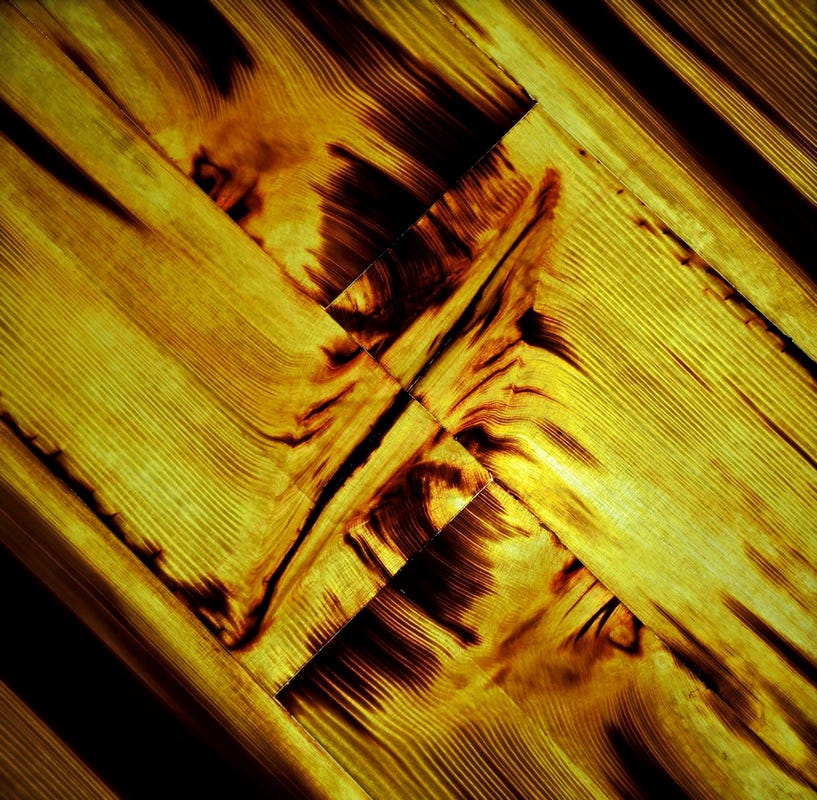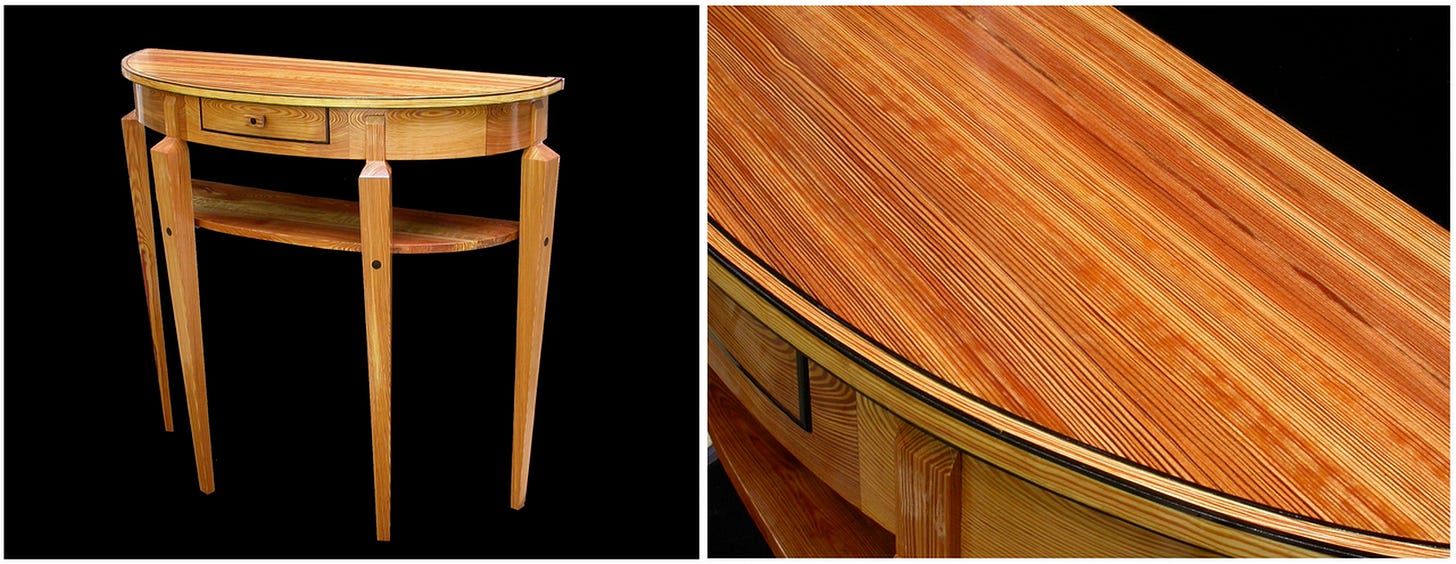Foresters and lumbermen often claim that lumber is a renewable resource, and I suppose it is if your opinion is that "wood is wood." But it isn't hard to distinguish wood coming from mature trees in old-growth, virgin forests and wood of the same species coming out of second growth (i.e. renewed, renewable) forests. Second-growth redwood, Douglas fir, western hemlock, tulip poplar and many other species are to the real thing as Formica is to marble. The sad truth is that wood from old-growth forests is a non-renewable resource, and to extract it is a lot like mining. Here in the South, the old-growth forest was mostly longleaf pine. Nowadays, there are only two ways you can get old-growth longleaf pine lumber: salvaging buildings built before 1920 or milling “sogs”--- logs that were too dense to float to the sawmill and have lain on the bottoms of rivers for more than a century. Retrieving sogs requires equipment and a state permit, neither of which I have, but my enthusiasm for scrounging knows few bounds, so my Found Objects for this essay are pieces of longleaf pine joists salvaged from a historical building.

The longleaf forests in my neck of the woods once extended over most of the coastal plains from Virginia to Texas. It was an airy, open forest with a dense ground cover of highly flammable grasses that burned every 2 or 3 years, assuring that few shrubs survived. It was essentially a grassland with trees. Trees died and were replaced more or less one by one, the victims of lightning or extreme old age. In these nutrient poor soils, young trees competed intensely with their older neighbors and grew slowly. As a result, the wood is dense and hard, the growth rings narrow and straight, and because the trees lived 200 to 400 years, their heartwood is saturated with resin to preserve it from rot and insect attack. At the extremes of resinousness, the wood is not only delightfully flammable, but thin slices of it illuminated from behind glow with a warm, honeyed light.

Contrast this magical old heart pine with the coarse, lightweight second growth longleaf pine with its wide growth rings, its surplus of spring wood and its lack of resinous heartwood--- perhaps OK for standard 2 by 4s for building a shed, or a plank or two for a bookshelf supported on concrete blocks, but you wouldn’t pay honest money for fine furniture made from it. In contrast, a panel of clear, straight, heart pine is, at least to me, a thing of beauty to be treated with reverence like an ancient scholar, respectfully with awareness of its long, productive life in an ancient forest.

Working old-growth longleaf is a delight for the senses and the intellect--- the odor of turpentine fills the air, the resinous, sticky sawdust forms stalagmites under the table saw, the pitchy, translucent wood glows yellow to red and the narrow growth rings record the history of centuries. To use such wood is to use history for a modern creation. Some of my furniture, such as that below has wood that was laid down before George Washington was born, or perhaps even before his father was born. With luck, second growth longleaf might take you back to the Great Depression.

The original longleaf forest was pretty much gone by 1920. Here in Tallahassee, any building that predates 1920 was probably built with this virgin pine, and this pine sometimes becomes available again during the renovation or demolition of old buildings. My first salvage experience was a charming old church built in the 1880s whose black congregation had outgrown the church. Its demolition in 1975 was crude, with little regard for salvage value, but what could be salvaged was free for the taking. Transporting several 25 foot long 2 x 10s or 3 x 12s on the roof of my 14-foot-long VW Squareback was probably worthy of a cartoon, but it started my collection of salvaged longleaf pine.
A second big infusion came from the demolition of Tallahassee's first public high school, a 4-story building whose uses had included a whore house before finally ending as an apartment building. I made friends with the man doing the demolition brick by brick, joist by joist and plank by plank. He had tired of tobacco farming and discovered not only that salvage was a steadier source of income, but also that it satisfied his scrounging nature. As I had a similar scrounging nature, we understood each other well, and the price he gave me for one fine joist after another couldn't be beat.
By the mid-1990s, salvaged longleaf had become chic, commanding an ever-increasing price, and with truckloads being shipped as far as Chicago. The final addition to my stash came from the renovation of Reynolds Hall on the Florida State University campus. The demolition of the interior longleaf pine structure was a lot more careful than that of the church that produced my first salvage. The rough-sawn floor joists ran from a pocket inside the brick exterior wall to a pocket in the opposite wall. The walls were a part of a historic preservation, and to prevent damage, the workmen simply cut the joists just outside the pockets and dropped the joist below. I bought a lot of the resulting 2 x 10 joists, but as far as the sellers were concerned, the short pieces that fell out of these pockets were trash, or firewood at best. But Reynolds Hall was built in 1912, so to me these short pieces are a historical record of the original longleaf pine forest and are my Found Objects for this essay (see above).

Counting backwards from the youngest rings, some of these pieces had rings that were laid down before 1700. Most of this lumber lacks sapwood, which was lost as wany edged waste, so a more realistic estimate of the ages of rings would suggest adding 20 to 30 years. Therefore, the dates in the image below should probably be 20 or more years older. I eventually shared slices of a few dozen of these pieces with a couple of tree ring specialists who puzzled out the meaning of variations in ring width in relation to weather/climate. This is not a simple thing because the effect of between-tree competition and soil must be eliminated to detect any climatic signal.

During the Reynolds Hall caper, I was paying almost market price, so cheapskate that I am, I stopped collecting, despite my frequent proclamation that "a boy can't have too much lumber." But to be honest, my storage shed was packed to the rafters (below). I had enough salvaged longleaf pine to last a couple of lifetimes, but as far as lifetimes go, it is still only one to a customer, and I have used up most of mine.






Just beautiful! Your art in all forms is wonderful!